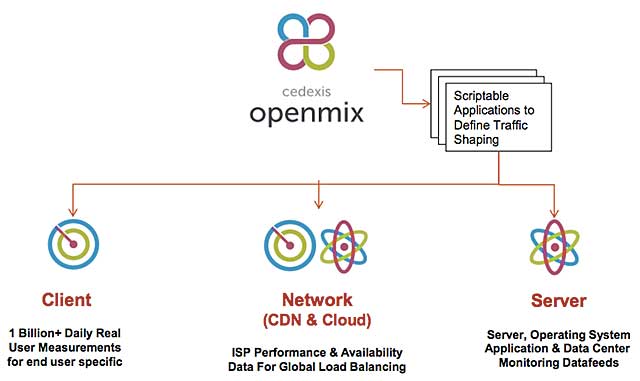Cedexis Saves Load Times with Billions of Tests per Day
"Our goal is fairly modest," said Robert Malnati, vice president of marketing for Cedexis, somewhat tongue in cheek. "We want to make the internet better for every user."
Cedexis and its Openmix service unification attempts to automate the optimization of end-user experiences across vendors, from content delivery networks (CDNs) and off-net points of presence (POPs) to on-net cloud and public/private data centers.
"Openmix sits between network core and the end-user," said Malnati. "We use 48 nodes deployed around the world, across a variety of data centers, to confirm real-time optimization. At its core, Openmix is a load balancer."
An end-user device first downloads Radar, written in JavaScript, and then requests objects from a variety of locations. So is Cedexis using a peer-to-peer arrangement to optimize content delivery? No, because the test objects only come from the pre-defined nodes, and no information is passed from one client to another.
"It's not P2P, but a measurement of how bandwidth and object optimization can shave seconds off a page load," said Malnati. Openmix is akin to an automated DSL Reports test run.
"Except we do this billions of times per day," Malnati said.
The more complex a customer's needs, the better Cedexis can provide recommendations on optimizing object delivery.
"If you're picking just one CDN or one data center to serve content, the complexity isn't enough to challenge Openmix," said Malnati. "Besides insight into CDNs and public data centers, Openmix has insight into the last-mile ISPs. For instance, in China, we're able to provide information on the nine primary ISPs within mainland China, offering our customers insight into the load times of particular video or media objects."
Cedexis doesn't resell CDN services, but it does share information publicly about the testing it does across multiple CDNs.
"Our algorithms can break the cache, and probe, so that we're certain the testing isn't being gamed," said Malnati. "We then share our testing information publicly, as well as giving more detail to each specific paying customer.
"For our customers that want to optimize even further, we provide an audit report based on actual customer transactions," he added. "In addition, since we have so many tests per day, we can simulate a customer's current load times against the community data to see what impact the companies would have if they'd used additional resources: other CDNs, private or public data centers, major cloud service providers."
While the Radar applet is from the end-user, Cedexis is launching a new service called Fusion which pulls large datasets from cloud providers, CDN APIs, and other partners.
"On shopping cart abandonment or delays, for instance, we work with existing partners and measurement tools such as Catchpoint, Keynote, and Gomez," Malnati said. "For applications, including those that have a heavy video component, we use application performance monitoring (APM) to see whether a particular provider is trending towards capacity exhaust."
The goal of Fusion, according to Malnati, is to take the large datasets, parse and evaluate them and then push test subsets out to all 48 Openmix nodes within 15 seconds.
Cedexis sees several benefits for data-heavy delivery, including video delivery. One simulation it has continued to hone is that of burst testing where a customer may want to experiment with load times across multiple CDNs to avoid bursting financial and performance impacts.
"Customers can write a custom PHP script to allow for overweight for bursting, which we refer to as application defined networking," Malnati said. "In addition, we take the best custom scripts and generecize them: If a customer writes an app to simulate CDN performance at 90 percent capacity, and then overweights a second CDN once contracted data traffic has reached the 95th percentile, we can take that script, strip out the CDN information and make the script available so other customers can add their own specific CDNs into the script for testing."
One growth area is the ability to coordinate purges across multiple CDNs.
"Now with Radar and Fusion, we've given tools for monitoring at two key locations," Malnati said. "Our customers can monitor delivery experience at both the end-user as well as the network core, and we will also be launching an updated dashboard within the next thirty days to reflect both Radar and Fusion feedback in an easy-to-use user interface."

Related Articles
Even SMBs need to think about load testing these days to ensure they can serve audience demand. Here are three questions to consider.
03 Oct 2016
Partners include Juniper, Rackspace, Amazon, Limelight, Tata, and more as services now measure more than 100 cloud and CDN platforms
02 Apr 2014